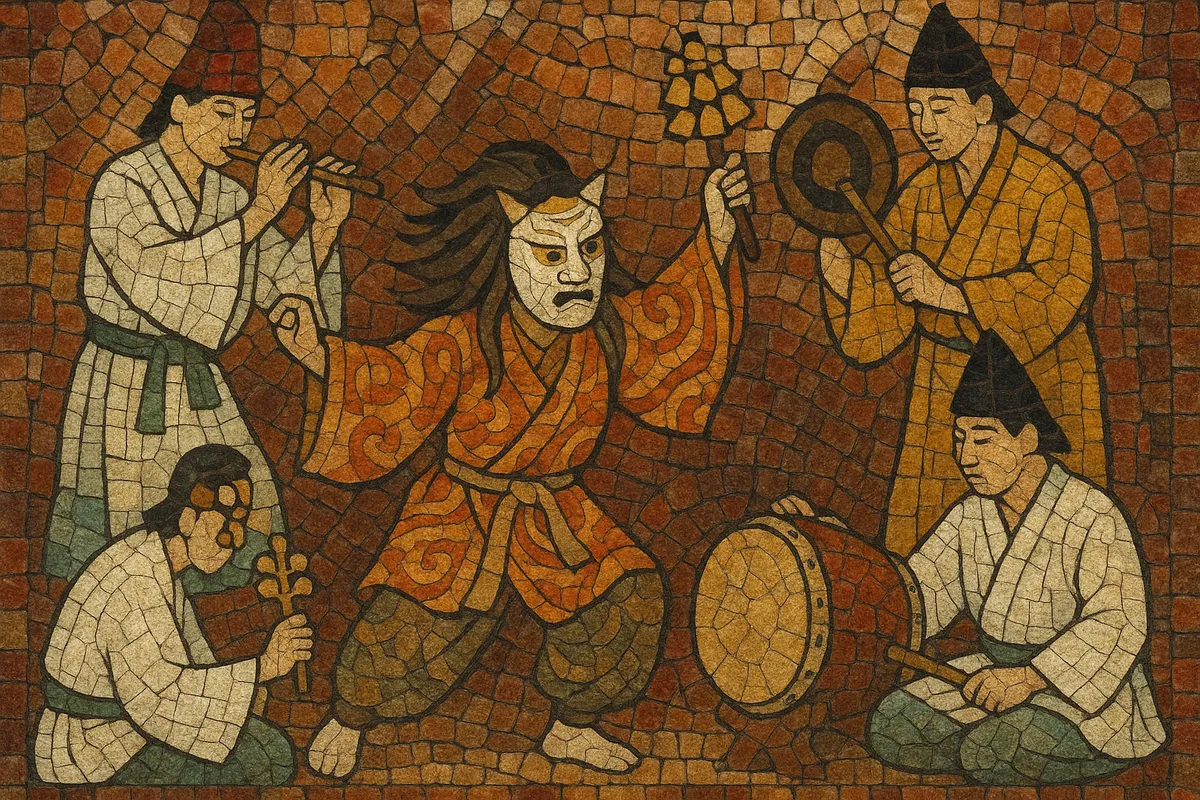Kagura is a Shinto ceremonial music-and-dance tradition from Japan, performed at shrines to honor and invite the presence of kami (deities). It blends ritualized choreography, mask and costume play, chant, and an ensemble of flute, drums, gong, and hand bells.
The music typically uses repeating rhythmic cycles and pentatonic modes, creating a solemn yet uplifting atmosphere suited to purification, thanksgiving, and mythic storytelling. Regional schools range from austere court-derived forms to lively folk styles that feature dramatic scenes such as serpent-slaying and lion dances.
Kagura emerged during Japan’s Nara and early Heian periods as a Shinto rite that combined invocation, purification, and celebration. Rooted in shrine ritual and mythic narratives, it absorbed courtly aesthetics over time while retaining an indigenous spirit of offering and communion with the kami.
Two broad lineages developed: more formal shrine and court-influenced practices, and vibrant local/folk variants tied to seasonal festivals and community protection. Court culture (gagaku/bugaku) and Buddhist liturgical aesthetics (shōmyō) informed timbre, pacing, and decorum, while village traditions emphasized narrative spectacle and communal participation.
Distinct regional styles—such as Takachiho-no-Yokagura in Kyushu, Iwami and Izumo Kagura in the San’in region, and Hayachine and Yamabushi Kagura in Tōhoku—codified repertoires of dances (mai), masks, and instrumental patterns. Many incorporate episodes from the Kojiki/Nihon Shoki myth cycles and shrine-specific legends.
In the 20th and 21st centuries, preservation societies and local troupes revitalized kagura as both living ritual and stage art. Festival circuits, cultural heritage designations, and youth training have sustained instrument craftsmanship, mask-making, and performance technique. Today, kagura appears in shrine precincts, community halls, and theaters while remaining anchored to Shinto ritual aims.
Use a small shrine ensemble: transverse bamboo flute (kagura-bue), taiko and shime-daiko drums, a small gong (kane), clappers (hyōshigi), and hand bells (kagura suzu). Keep textures sparse and percussive, letting flute lines weave above steady drum ostinati.
Build on repeating rhythmic cycles at moderate tempos, with clear cadential cues for choreography. Structure sections as invocation (quiet bells and flute), main dance (drum-driven patterns with flute motifs), and closing blessing (bell flourishes and unified hits).
Favor Japanese pentatonic modes (yo and in scales). Compose stepwise flute melodies with ornamental bends and sustained tones. Balance dry drum attacks with the shimmering overlay of bells to evoke ritual clarity and purification.
Pair music with codified dance gestures, mask entrances, and prop usage (e.g., swords, fans, serpent costumes). Align musical cues to deity appearances, exorcistic actions, and climactic tableaux. Maintain dignified pacing, even in vigorous folk scenes.
Begin with purification sonorities (bells, soft flute) and maintain respectful dynamics for sacred spaces. Use call-and-response drum figures to energize community participation while preserving a solemn, reverent tone.


